Generative AI (GenAI) is already transforming our ways of working and productivity. AI tools are being used by 68% of employees without their bosses’ knowledge, according to a US survey three months after ChatGPT’s public launch. This mass experimentation is happening organically and at a rapid pace thanks to GenAI’s low barrier to entry and vast application potential; this means it lacks coordination, governance or structure.
Yet without taking a strategic approach to AI and innovation, your organization will starve on low-hanging fruit. It’s not enough to just invest in AI solutions — your competitors are doing that too! Your future competitive advantage will depend on your ability to integrate those solutions into your processes and products to make them specifically helpful to your organization.
The glacial pace of traditional organization strategy won’t keep up with GenAI adoption and advancements. The AI ecosystem is evolving so rapidly that any multi-year AI strategy will be out of date before it is finished.
That’s why organizations need a systemic and adaptive approach to AI strategy. One that focuses on developing capabilities as it innovates. One that draws on the tools and practices that have already been proven through decades of tech-enabled transformation.
We have been through game-changing revolutions before, including the first days of the internet, smartphones and then the cloud. These may have been slower to start, but just like GenAI, they became ubiquitous. The lessons we learned from these revolutions still apply today — including how it will affect the nature of work, how we prioritize experimentation, and the risks of being too quick or too slow to invest.
At Thoughtworks, we have been applying agile principles to strategic activities for many years. EDGE and Pathfinder are two proven toolkits, one focusing on strategy and execution and the other amplifying innovation. This guide will take you through how these frameworks can improve innovation as well as the overall quality of strategy and execution. These proven practices and tools help organizations respond and take control of their AI strategy so they can leverage its full potential across the organization.
The AI ecosystem is evolving so rapidly that any multi-year AI strategy will be out of date before it is finished.
Perfection is the enemy of progress
Understandably, AI is also on the board’s agenda. They fear missing out — when questioning CEOs and tech leaders they’re eager to find out how we plan to respond and adapt. They want to know what the competition is doing and whether our value streams will be disrupted.
They see opportunities, but they’re also worried. They want to embrace GenAI, but they don't want to expose the company to reputational or other risks. These forces actually create another risk: the risk of focusing on short-term profitability at the expense of long-term business prospects.
The most important message to boards is this: you cannot wait for the perfect plan. You need to take small, substantive steps today, embedding both AI capabilities and continuous delivery practices across the organization. And it needs to be a coordinated approach, or the effort will be wasted.
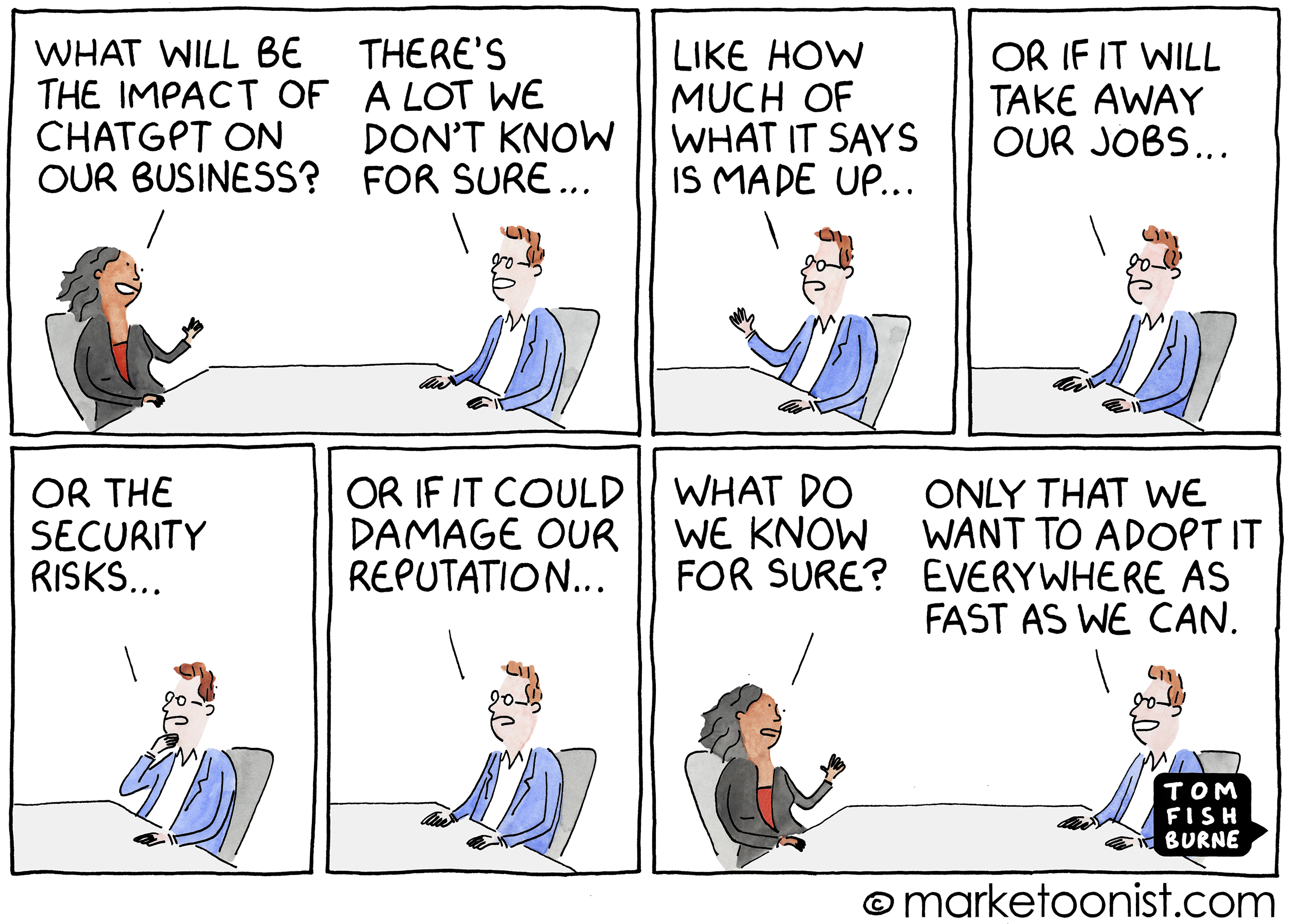

Figure 1. ChatGPT fear and FOMO Source
We are already seeing the organization-wide impacts of GenAI. According to a McKinsey analysis of GenAI use cases, about 75% of their value covers four areas: customer operations, marketing and sales, software engineering and R&D. Software engineering is likely to experience the greatest productivity lift, valued at around 25%-45% of its spend.
These findings suggest significant efficiency savings with a tangible ROI. It’s no wonder we’re seeing a new wave of interest in and adoption of AI. But while GenAI tools provide many people's first conscious interaction with AI, it’s important to remember that AI has been embedded in our phones, in features such as predictive text and photo editing software, for years.
Yes, GenAI feels different. But it should not be the sole focus of your AI strategy. There are many other opportunities beyond large language models. AI investment should be holistic, strategic, and committed to moving beyond the hype.
What does this mean in practice? Primarily, it requires tools and frameworks that can help you scan the broader AI landscape and identify ways you can leverage it. To do that effectively, there are three key steps we think you should follow. Together, they will help you ensure AI produces tangible and sustainable value.
1. Set your AI North Star
The first step in any strategic approach to emerging technology adoption is to ensure it aligns with your broader business goals in the short and long term. It’s tempting to focus on projects and place multiple bets as ideas emerge. Instead, you need to prioritize goals with adaptive, value-driven portfolio management. To arrive at this proven approach, we’ve applied the same agile principles to this overall process as our EDGE operating model. EDGE follows an iterative and adaptive process to align and execute on strategy, measuring value to steer and adapt the strategy on an ongoing basis.
Adapt with a value-based portfolio approach
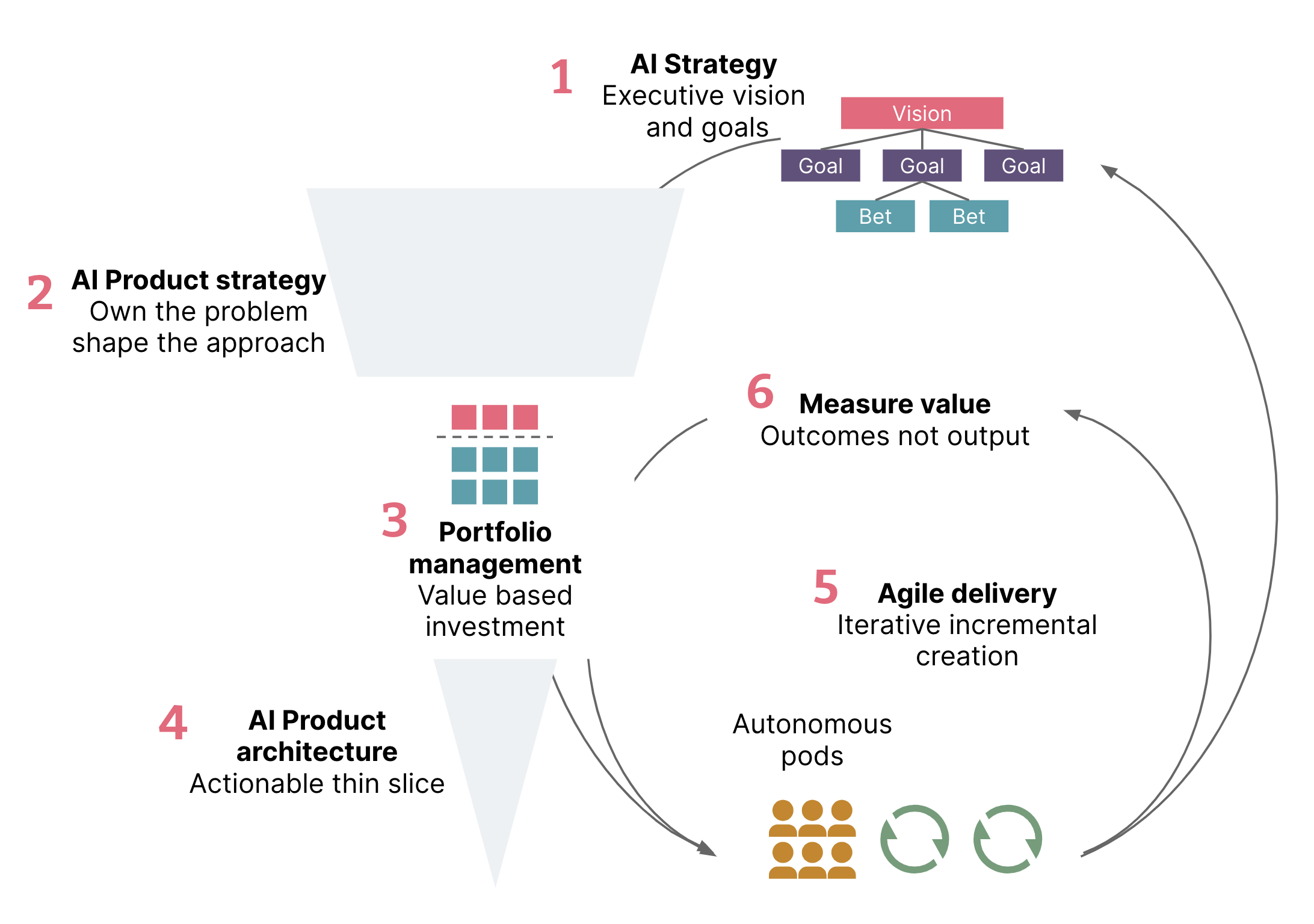

- AI Strategy: Leaders guide empowered teams through a shared AI strategic vision. Organization level strategy is communicated through outcome based goals.
- AI product strategy: problem space analysis to shape a high level approach and identify hypotheses towards achieving goals.
- Portfolio management: investments are allocated based on value. The work in progress is limited. Stop starting, start finishing!
- AI Product architecture: Value is turned into actionable, thin slices ready for delivery. Large programs of work are broken into small ‘learning driven’ chunks.
- Agile delivery: an adaptive and incremental approach to delivery with fast feedback loops early and often.
- Measure value: work is measured on value delivered, not work output.
EDGE works like this: you begin with a clear vision of what you’d like to achieve, then set multiple goals that will make that vision a reality, and then make a range of hypotheses that describe possible ways to achieve those goals, as shown in the Lean Value Tree model below.
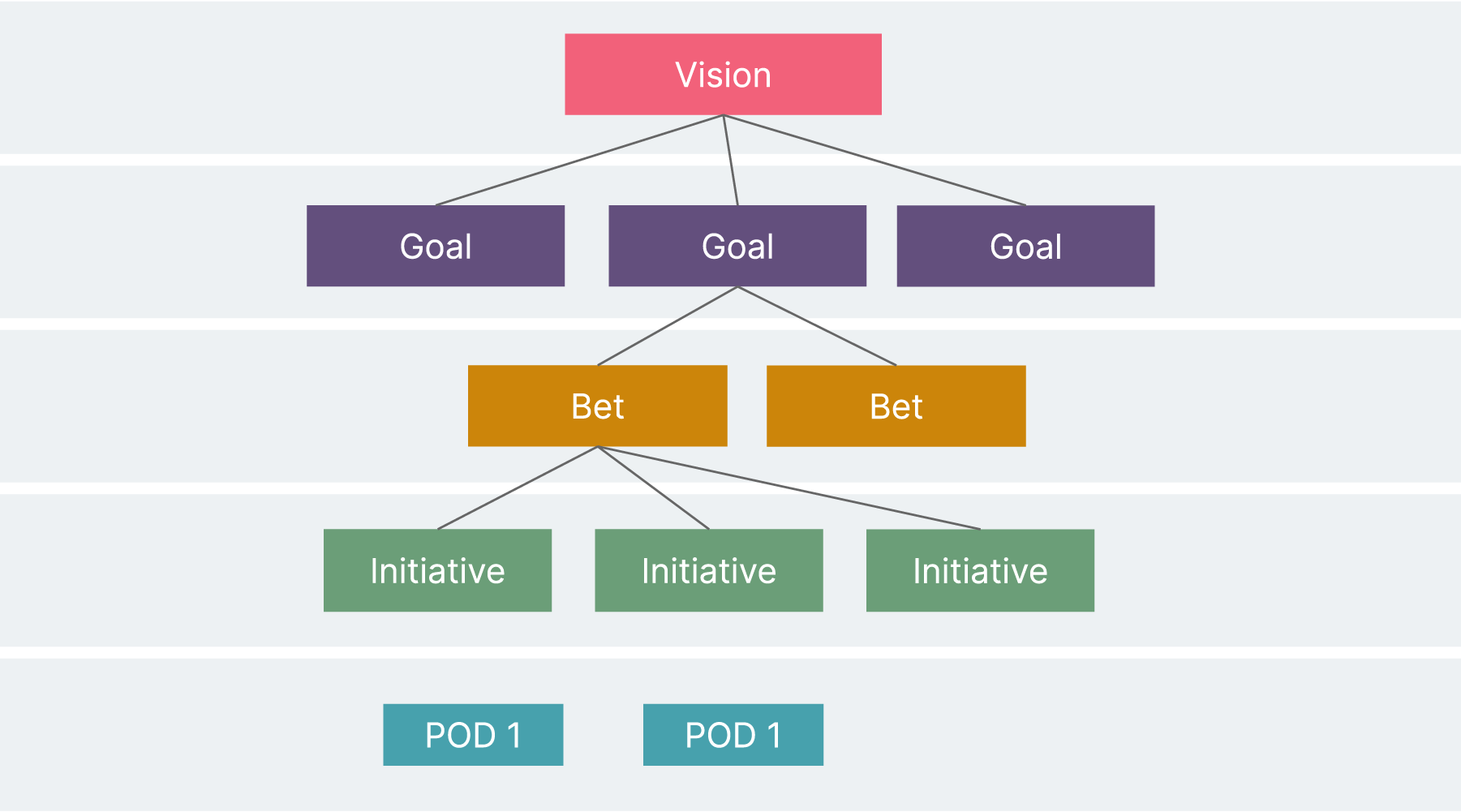

Figure 2. Lean value tree
Lean Value Tree:
The overall vision at the top of the tree sets a guiding direction toward which all investments should contribute.
Goals are created from business drivers to deliver upon the vision
Bets are more specific ways in which goals might be realized in the market
Initiatives are actions that deliver tangible value. Initiatives have a clear customer need and business opportunity defined.
Self-sufficient teams/PODS are assigned responsibility for delivering on the outcome of initiatives.
The vital ingredients needed to make this model work consists of a set of multiple hypotheses, an adaptive organizational structure and the ability to measure and follow work.
By testing multiple hypotheses, you can increase your chance of success and minimize the risk of failure. But you also need to quickly adapt and pivot when hypotheses don't pan out.
In an adaptive structure, learning and progress never stop. You’re constantly testing new hypotheses and adjusting plans as you learn more. This helps you deliver value while also accelerating the adoption of AI.
A clear set of goals and objectives is essential for measuring and following the work in the EDGE model. By knowing what you want to achieve, you can determine which metrics are most important to track. Using a variety of metrics will give you a holistic view of your progress, and tracking your progress over time will help you identify areas where you need to make adjustments. Finally, communicating your progress to stakeholders will keep them informed and engaged in your initiatives.
2. Make AI accessible to all
AI is no longer constrained to an organization's machine learning and data teams. For example, with the swipe of a credit card, product teams can leverage AI tools to enhance their efficiency in ways that only a few years ago seemed impossible. That’s why AI adoption requires AI literacy and capabilities across all functions, including non-technical ones.
To navigate the complex ecosystem of GenAI tools, give employees guidelines that encourage experimentation and learning, but also highlight the risks. Develop a responsible AI framework and policies that address privacy, security, law and regulations.
Different roles within your organization will need different levels of understanding and capabilities.
Embedding AI capacity within the organization
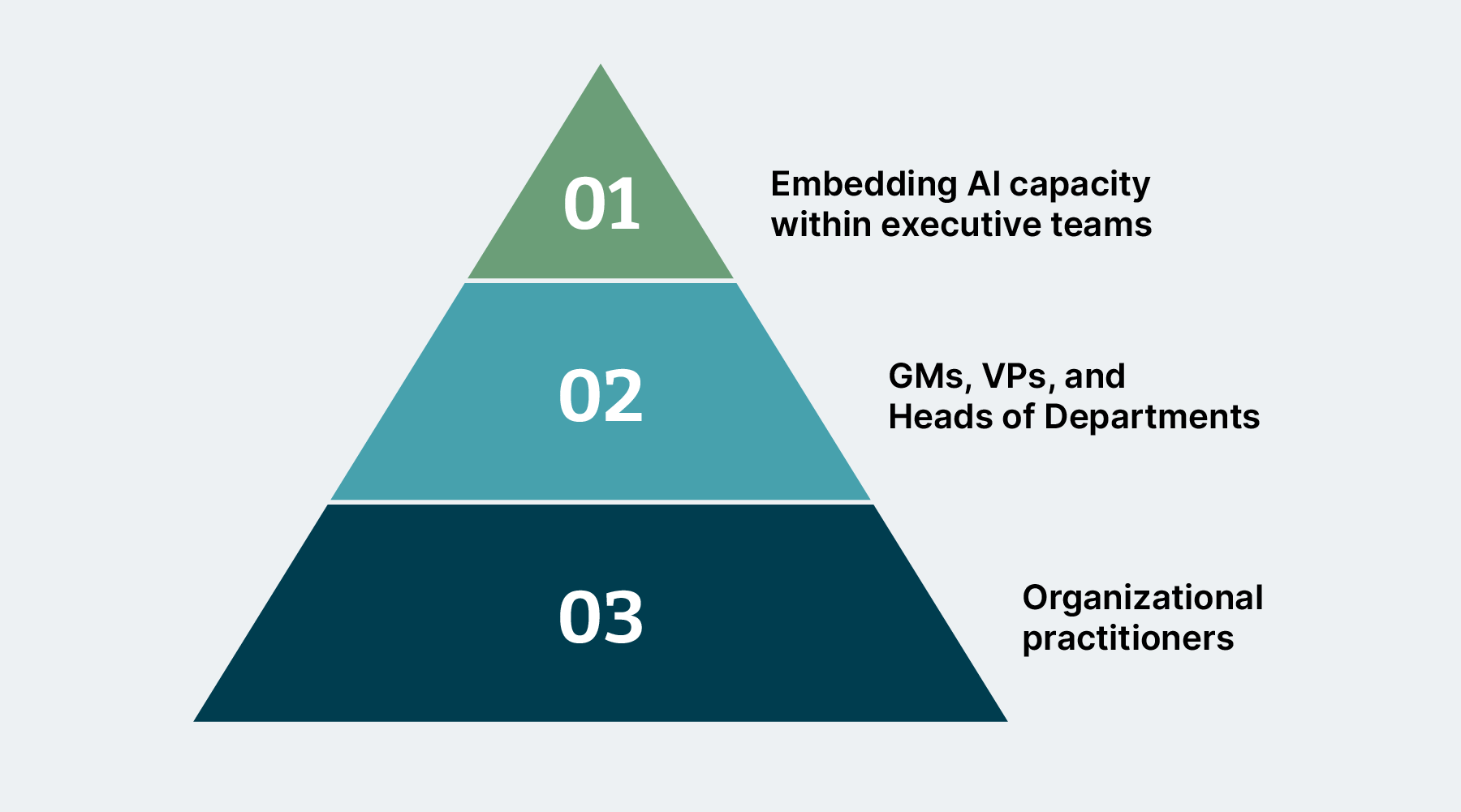

Executive teams:
High-level training to build a shared understanding of generative AI to enable strategic decisions.
Education on the potential benefits, ethical considerations and risks.
GMs, VPs, and Heads of Departments
In-depth training to identify opportunities and value streams that would benefit from or be disrupted by AI.
Training on how to assess the feasibility of AI projects and how to manage their risks.
Organizational practitioners
Training that is tailored to their role type and domain.
Education on AI and GenAI, the tools available and organizational guidelines for use and adoption.
They should be able to identify AI opportunities within their products, services, and teams.
3. Adopt an experimental mindset with lean practices
As you progress on your journey as an AI-first organization, you will need to empower your teams to continue to look for new ways to solve problems and make improvements. This means creating an environment where teams are unafraid to experiment and try new things, even if they fail. This may require technical and process controls along with significant cultural change.
Here are some specific things you can do to create an innovator's mindset in your organization:
Encourage curiosity and questioning. Reward employees for asking questions and challenging the status quo.
Celebrate failure. Make it clear that failure is a part of the learning process and that it is often necessary to take risks in order to succeed.
Provide opportunities for experimentation. Give teams the resources to experiment with new ideas and learn from their mistakes.
Reward creativity and innovation. Recognize and reward employees who come up with new and innovative ideas.
Pathfinder's distinctive approach of combining lean delivery practices, data-driven hypothesis development and continuous delivery will consistently foster an environment for effective innovation.
Pathfinder improves business outcomes by accelerating experimentation and focusing on delivering value. For example, introducing Continuous Delivery for Machine Learning (CD4ML) allows you to effectively capture the value of initial experiments and supports future rounds of innovation.
Data-driven hypothesis development uses a simple ‘hypothesis canvas’ to capture key aspects of an idea, including success criteria, metrics and ethical considerations. This ensures experiments are conducted consistently and shares learnings so you can iterate quickly and efficiently.
The hypothesis canvas should focus on the problem you’re trying to solve and the customers (internal or external) that are impacted. It’s important to capture the expected outcomes that will determine the measures of success. Then, you can design the right work to achieve those outcomes, identify the skills and teams needed, and start tracking individual experiments to get there on an experiment canvas.
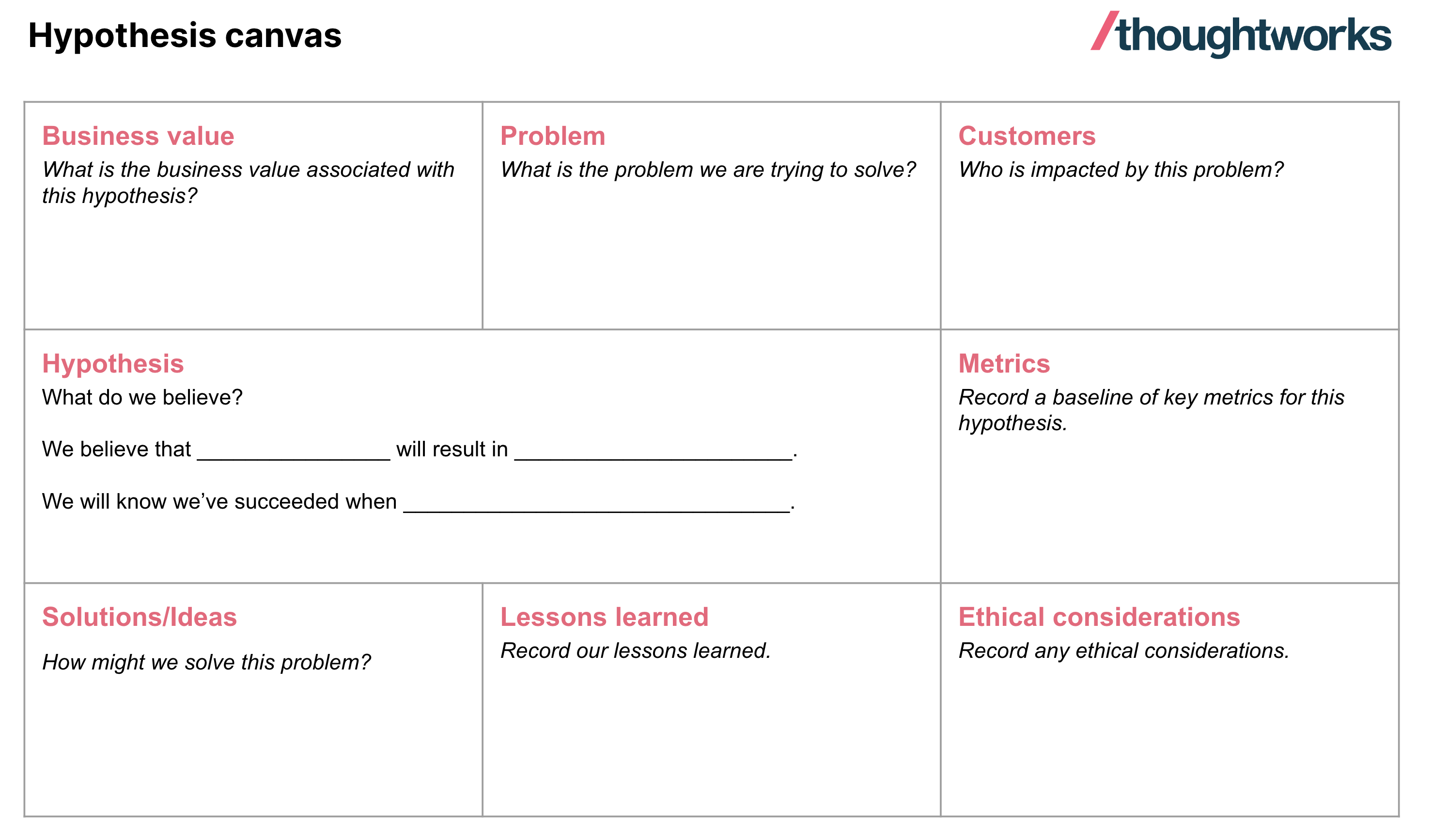

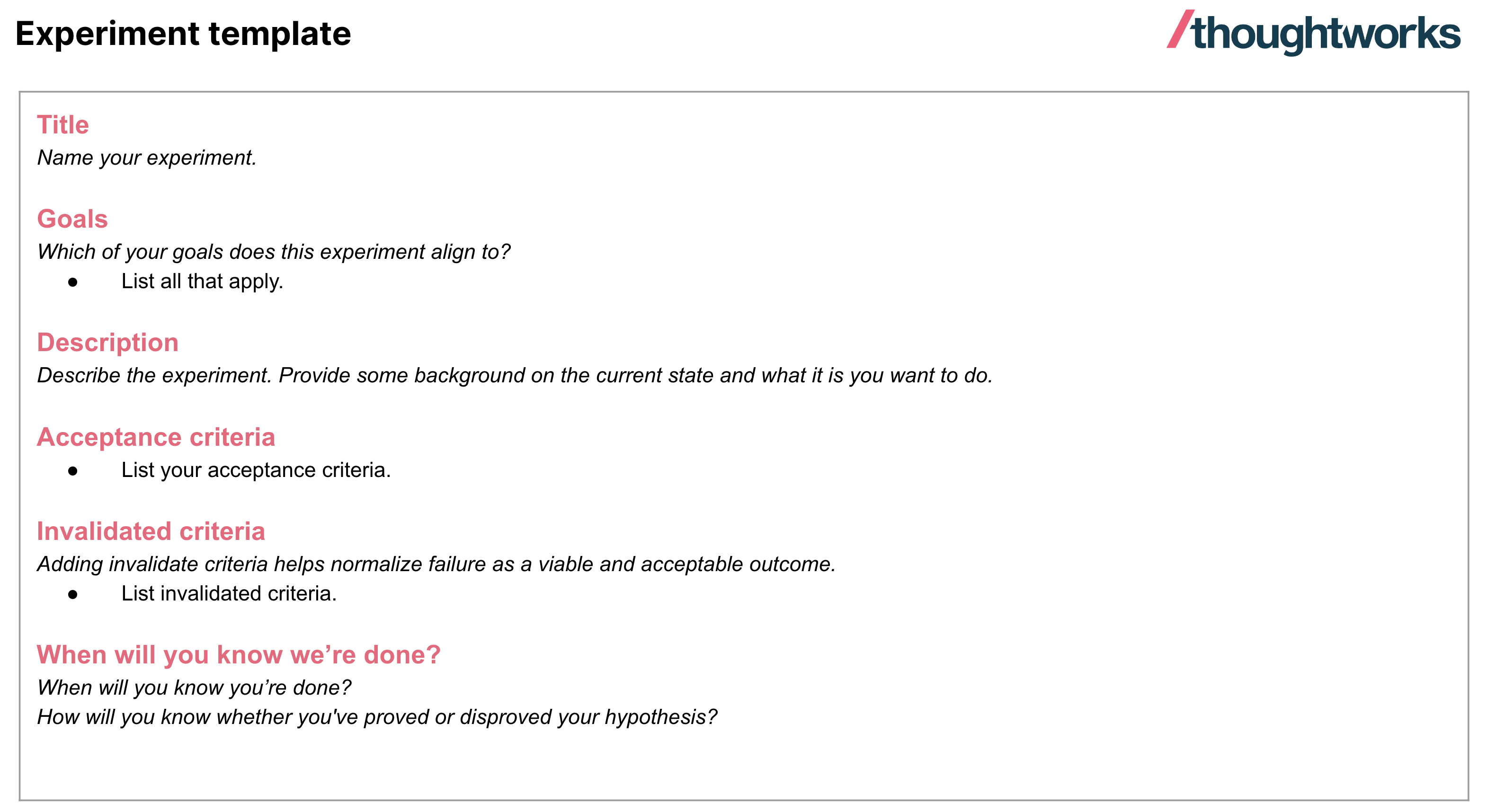

Figure 4. Experiment canvas
Innovation doesn't always go as planned. It often takes multiple experiments to prove or disprove a hypothesis. It is a process of experimentation and iteration, and this long and winding process can cause confusion and frustration for stakeholders. That’s why visualizing goals, progress and success with these tools can make it easier to share learnings and outcomes throughout the organization and ensure every experiment has a meaningful link back to your Lean Value Tree.
A simple experiment dashboard can also help you keep stakeholders engaged and communicate progress effectively. The more they learn, the more empowered they will feel.
Make everyone feel like they are part of the journey and aligned with the same goals by:
- Keeping it simple – make it easy to understand and navigate.
- Using clear visuals – graphs and charts helps stakeholders understand your data.
- Keeping it up to date – make sure it’s meaningful and relevant.
- Widely sharing the dashboard – make sure it’s available.
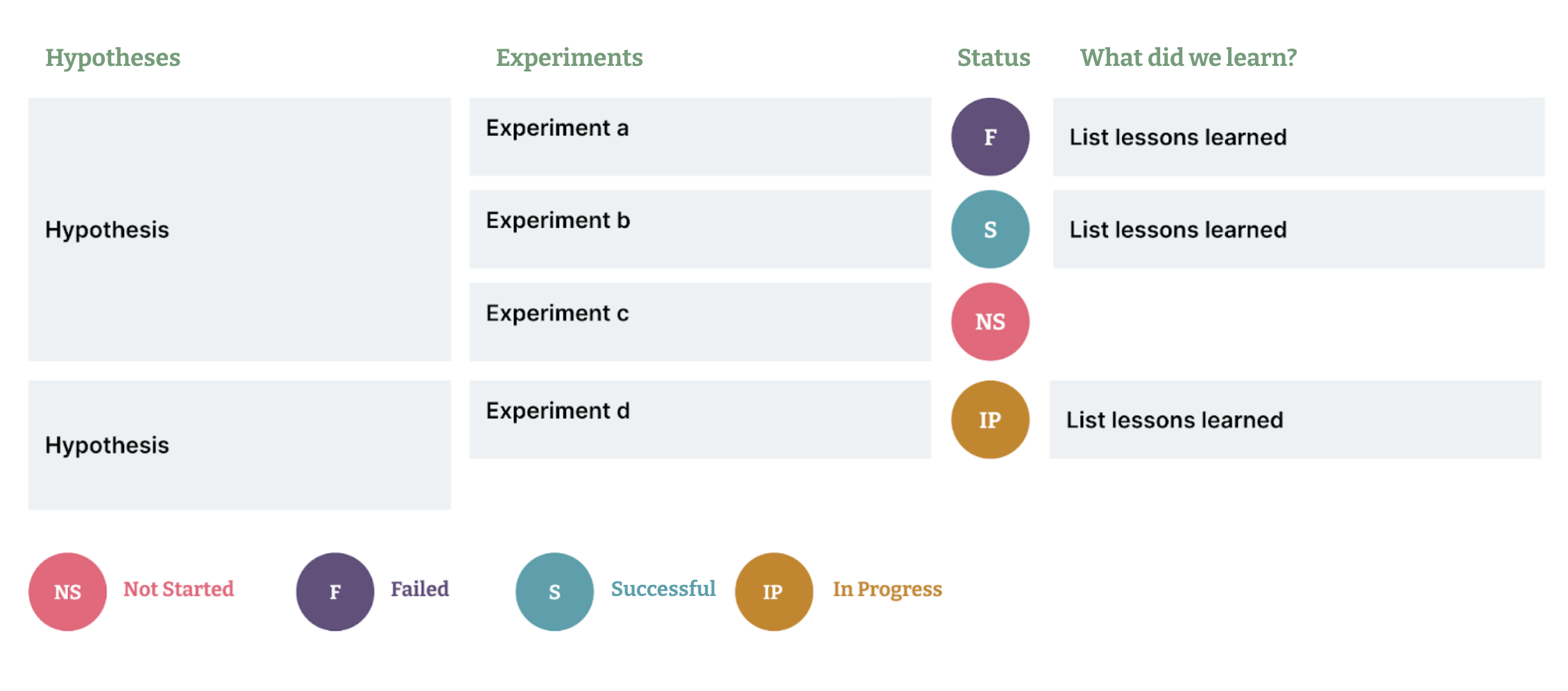

Figure 5. Experiment tracker dashboard
Build your AI strategy today, disrupt tomorrow
Few business leaders can afford to ignore GenAI, and its development is moving at breakneck speed. So how can you capitalize on its capabilities today and satisfy the fast-emerging needs of users within your organization while also planning for its future potential?
A strategic partner may be able to help you understand AI’s likely evolution to help rebuild your strategy beyond the low-hanging GenAI fruit of today. They can also level the playing field within, ensuring everyone has access to the right AI knowledge and tools for their role and domain.
For example, we are working with tech leaders to equip them for board meetings by empowering teams with the EDGE operating model and Pathfinder’s innovation processes to redefine their AI strategy, align GenAI integration ideas with business goals, scale for value and build AI capabilities. The following five steps, which combine both EDGE and Pathfinder elements, are crucial for any organization seeking to reap benefits from generative AI:
Five steps to a systemic AI strategy
Develop a clear vision for how AI will be used in your organization.
Create a roadmap for the adoption and integration of AI tools.
Invest in AI training and education for employees.
Create an environment where experimentation and innovation are encouraged.
Develop policies and guidelines for the responsible use of AI.
By following these steps, you can find your own path to GenAI and reap the benefits of this powerful technology. And by using proven lean practices and continuous delivery models, you can create momentum for value-generating innovation. This is one of those ‘this changes everything’ moments, a seismic technology shift that comes around once every decade or so.
If you take a strategic approach to GenAI adoption, integration and innovation, you can create unique customer experiences, develop new products and services and generate new revenue streams. And while adoption so far has been ad hoc and bottom-up use-case driven, leaders now need to step in and act quickly, provide clear direction and set the innovation agenda.
Thoughtworks’ Pathfinder framework is ideal for enabling an enterprise-wide AI strategy. It combines the EDGE operating model with proven innovation processes to help organizations navigate a path to emerging technology adoption.
Pathfinder draws on the following principles:
Building an organization that can thrive in change: The EDGE operating model is based on three principles: multiple hypotheses, adaptive structure, and measures following the work. The EDGE model helps organizations be more agile and responsive to change.
Deliver value fast: The Pathfinder framework incorporates proven innovation processes such as lean delivery practices, data-driven hypothesis development, and continuous delivery. As a result, organizations can develop and deliver innovative products and services faster.
Value-driven approach: The Pathfinder framework takes a value-driven approach to innovation. This means that organizations focus on developing products and services that deliver value to customers.
Working with Thoughtworks, your teams can use the EDGE and Pathfinder frameworks to supercharge your AI strategy through execution and scale transformation across the business.
Disclaimer: The statements and opinions expressed in this article are those of the author(s) and do not necessarily reflect the positions of Thoughtworks.


















